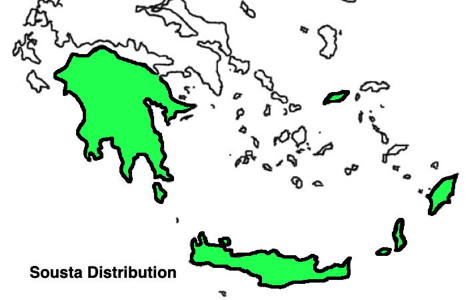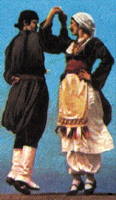
|
The Society of Folk Dance Historians (SFDH) Sousta
[
Home |
About |
Encyclopedia | |
CLICK AN IMAGE TO ENLARGE

Characterized by the up-and-down movements of the Cretans, these dances reminded the Venetians of a carriage bouncing on its springs, hence the name sousta (spring). Dance authorities believe that the great grandaddy of these soustas was the ancient Pyrrhic war dance. There is an element of opposition in most of these dances.
 When the Turks occupied Crete in the early 1800s, many Cretans fled the island in two directions. Some went northwest by way of Anti-Kythera and Kythera to the Mani Peninsula of the Peloponnesus. Others took then northeasterly route to Kasos, Karpathos, Rhodes, and the other islands of the Dodecanese. There is little doubt that the Cretans influenced the dances of the areas where they landed. The Syrto Rhodou is a thinly disguised Cretan Syrto (but no Rhodian will ever admit it!).
When the Turks occupied Crete in the early 1800s, many Cretans fled the island in two directions. Some went northwest by way of Anti-Kythera and Kythera to the Mani Peninsula of the Peloponnesus. Others took then northeasterly route to Kasos, Karpathos, Rhodes, and the other islands of the Dodecanese. There is little doubt that the Cretans influenced the dances of the areas where they landed. The Syrto Rhodou is a thinly disguised Cretan Syrto (but no Rhodian will ever admit it!).
When Cretan chieftains were invited to help the Macedonians during the Balkan Wars, they left their mark. In the village of Bufi, near the Albanian border by Lake Perspa, they do a dance called Bufiotiko, better known by its Macedonian name, Bufčansko. It is the Cretan Syrto with a Macedonian styling. Of course, there is the ever popular Misirlou, another dance dance derived from the Cretan Syrto.
The musical instruments of Crete are the Cretan lyra (a pear-shaped, three-stringed bowed musical instrument) and the laouto (a long-neck fretted instrument of the lute family). The lyra provides the melodic line and the lauto the rhythmic structure. The fact that there are only two musicians allows them to become involved with the dancers and to feel the mood and increase the tempo or whatever else it takes to create that moment of exhilaration when the music and dancers are one.
As we move farther away from Crete, the dance begins to reflect the influence of the Venetians and the more "western" sounds of the violin and guitar. The dances are smoother and less "clipped" and "nervous." From 1400 to the 1800s, the mercantile empire of the Venetian Republic held strongholds on strategic islands throughout the Ionian Islands and some of the Aegeans. Their Kastros (fortresses) guard the approach of many of the harbors and the high ramparts overlooking important passageways. We experience this influence in the dance of Kythera, whose residents proudly claim that no Turk ever set foot on their island, but fail to mention that they were vassals of Venice for 400 years!
DOCUMENTS
This page © 2018 by Ron Houston.
Please do not copy any part of this page without including this copyright notice.
Please do not copy small portions out of context.
Please do not copy large portions without permission from Ron Houston.